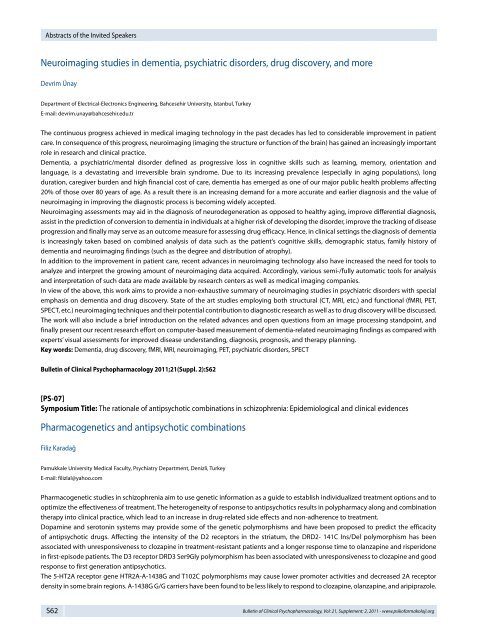SYMPOSIA
SYMPOSIA
SYMPOSIA
You also want an ePaper? Increase the reach of your titles
YUMPU automatically turns print PDFs into web optimized ePapers that Google loves.
Abstracts of the Invited Speakers<br />
Neuroimaging studies in dementia, psychiatric disorders, drug discovery, and more<br />
Devrim Ünay<br />
Department of Electrical-Electronics Engineering, Bahcesehir University, Istanbul, Turkey<br />
E-mail: devrim.unay@bahcesehir.edu.tr<br />
The continuous progress achieved in medical imaging technology in the past decades has led to considerable improvement in patient<br />
care. In consequence of this progress, neuroimaging (imaging the structure or function of the brain) has gained an increasingly important<br />
role in research and clinical practice.<br />
Dementia, a psychiatric/mental disorder defined as progressive loss in cognitive skills such as learning, memory, orientation and<br />
language, is a devastating and irreversible brain syndrome. Due to its increasing prevalence (especially in aging populations), long<br />
duration, caregiver burden and high financial cost of care, dementia has emerged as one of our major public health problems affecting<br />
20% of those over 80 years of age. As a result there is an increasing demand for a more accurate and earlier diagnosis and the value of<br />
neuroimaging in improving the diagnostic process is becoming widely accepted.<br />
Neuroimaging assessments may aid in the diagnosis of neurodegeneration as opposed to healthy aging, improve differential diagnosis,<br />
assist in the prediction of conversion to dementia in individuals at a higher risk of developing the disorder, improve the tracking of disease<br />
progression and finally may serve as an outcome measure for assessing drug efficacy. Hence, in clinical settings the diagnosis of dementia<br />
is increasingly taken based on combined analysis of data such as the patient’s cognitive skills, demographic status, family history of<br />
dementia and neuroimaging findings (such as the degree and distribution of atrophy).<br />
In addition to the improvement in patient care, recent advances in neuroimaging technology also have increased the need for tools to<br />
analyze and interpret the growing amount of neuroimaging data acquired. Accordingly, various semi-/fully automatic tools for analysis<br />
and interpretation of such data are made available by research centers as well as medical imaging companies.<br />
In view of the above, this work aims to provide a non-exhaustive summary of neuroimaging studies in psychiatric disorders with special<br />
emphasis on dementia and drug discovery. State of the art studies employing both structural (CT, MRI, etc.) and functional (fMRI, PET,<br />
SPECT, etc.) neuroimaging techniques and their potential contribution to diagnostic research as well as to drug discovery will be discussed.<br />
The work will also include a brief introduction on the related advances and open questions from an image processing standpoint, and<br />
finally present our recent research effort on computer-based measurement of dementia-related neuroimaging findings as compared with<br />
experts’ visual assessments for improved disease understanding, diagnosis, prognosis, and therapy planning.<br />
Key words: Dementia, drug discovery, fMRI, MRI, neuroimaging, PET, psychiatric disorders, SPECT<br />
Bulletin of Clinical Psychopharmacology 2011;21(Suppl. 2):S62<br />
[PS-07]<br />
Symposium Title: The rationale of antipsychotic combinations in schizophrenia: Epidemiological and clinical evidences<br />
Pharmacogenetics and antipsychotic combinations<br />
Filiz Karadağ<br />
Pamukkale University Medical Faculty, Psychiatry Department, Denizli, Turkey<br />
E-mail: filizlal@yahoo.com<br />
Pharmacogenetic studies in schizophrenia aim to use genetic information as a guide to establish individualized treatment options and to<br />
optimize the effectiveness of treatment. The heterogeneity of response to antipsychotics results in polypharmacy along and combination<br />
therapy into clinical practice, which lead to an increase in drug-related side effects and non-adherence to treatment.<br />
Dopamine and serotonin systems may provide some of the genetic polymorphisms and have been proposed to predict the efficacity<br />
of antipsychotic drugs. Affecting the intensity of the D2 receptors in the striatum, the DRD2- 141C Ins/Del polymorphism has been<br />
associated with unresponsiveness to clozapine in treatment-resistant patients and a longer response time to olanzapine and risperidone<br />
in first-episode patients. The D3 receptor DRD3 Ser9Gly polymorphism has been associated with unresponsiveness to clozapine and good<br />
response to first generation antipsychotics.<br />
The 5-HT2A receptor gene HTR2A-A-1438G and T102C polymorphisms may cause lower promoter activities and decreased 2A receptor<br />
density in some brain regions. A-1438G G/G carriers have been found to be less likely to respond to clozapine, olanzapine, and aripiprazole.<br />
S62 Bulletin of Clinical Psychopharmacology, Vol: 21, Supplement: 2, 2011 - www.psikofarmakoloji.org



